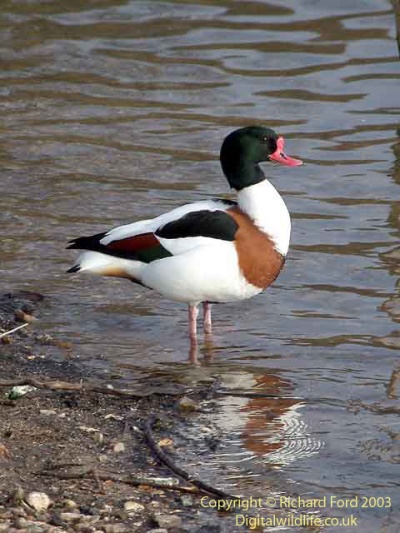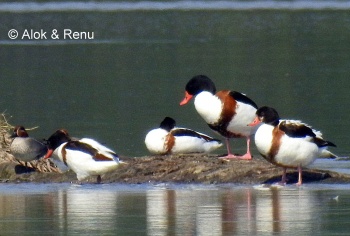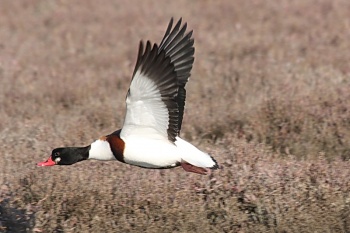
Photo © by redwing
- Tadorna tadorna
Identification
- White body
- Chestnut breast band
- Green neck and head (looks black)
- Black scapulars, flight feathers and stripe from breast band to vent
- Reddish-yellow undertail coverts
- White tail with black tip
- Red bill with fleshy knob (larger in spring Male)
Distribution
Palearctic region; winters to Near East, India and Myanmar.
Taxonomy
This is a monotypic species[1].

Wintering group in North India
Photo © by Alok Tewari
Nazafgarh Wetland and Marshes, Delhi-Gurgaon Border, India, February-2018
Photo © by Alok Tewari
Nazafgarh Wetland and Marshes, Delhi-Gurgaon Border, India, February-2018
Habitat
Estuaries, lakes, rivers and salt marshes.
Behaviour
Breeding
They nest in burrows, holes, caves and cliffs. The nest is lined with down for the 8-12 white eggs. Both sexes incubate and care for the young.
Diet
The diet includes invertebrates.
Vocalistion
References
- Clements, J. F., T. S. Schulenberg, M. J. Iliff, D. Roberson, T. A. Fredericks, B. L. Sullivan, and C. L. Wood. 2015. The eBird/Clements checklist of birds of the world: v2015, with updates to August 2015. Downloaded from http://www.birds.cornell.edu/clementschecklist/download/
- Collins Bird Guide ISBN 0 00 219728
- BWPI
- Wikipedia
- bio.edu.ee
Recommended Citation
- BirdForum Opus contributors. (2025) Common Shelduck. In: BirdForum, the forum for wild birds and birding. Retrieved 11 May 2025 from https://www.birdforum.net/opus/Common_Shelduck
External Links
GSearch checked for 2020 platform.1





